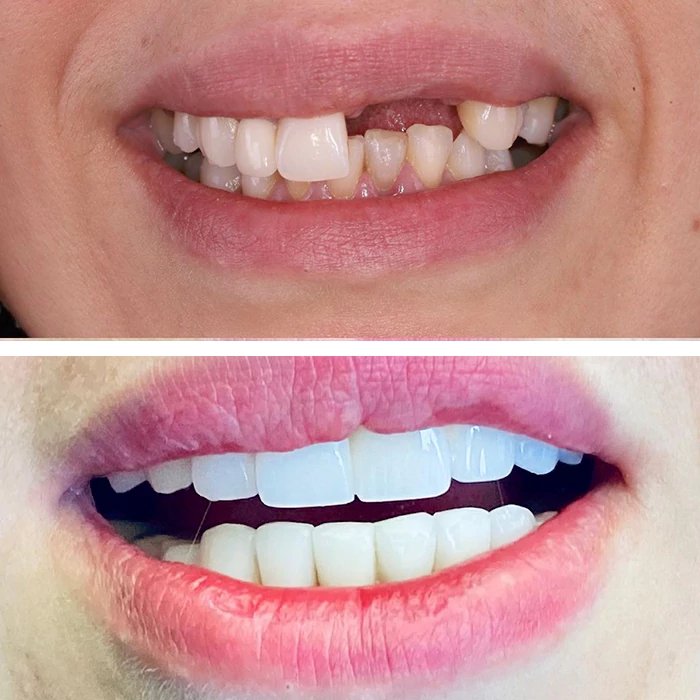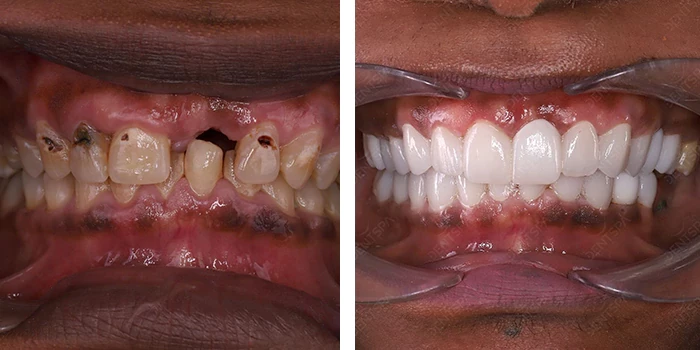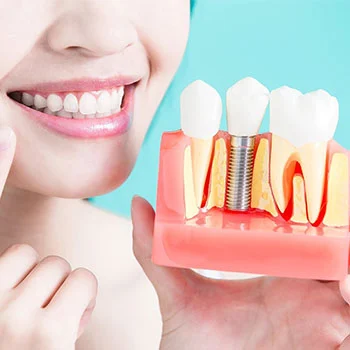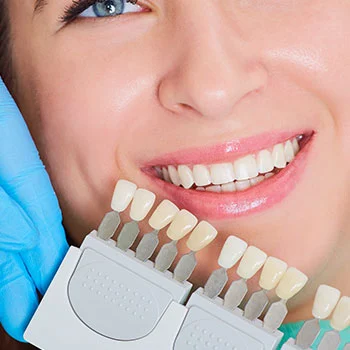What is a dental bridge?
A dental bridge is a dental restoration that is used to replace one or more missing teeth by bridging the gap between existing teeth. It consists of one or more artificial teeth, called pontics, which are anchored in place by dental crowns on the adjacent teeth, known as abutment teeth. Dental bridges can be made from various materials, including porcelain, metal, or a combination of both, depending on the specific needs and preferences of the patient.
Dental bridges offer several benefits, such as improving the ability to chew and speak properly, preventing remaining teeth from shifting out of position, enhancing facial aesthetics, and restoring confidence in one's smile.
What is the purpose of dental bridges?
The purpose of dental bridges is to replace one or more missing teeth and restore the functionality and aesthetics of the mouth. Here are some key purposes of dental bridges:
- Restoring missing teeth: Dental bridges fill the gap left by missing teeth, preventing the surrounding teeth from shifting out of position. This helps maintain proper alignment and bite functionality.
- Improving chewing and speaking ability: By replacing missing teeth, dental bridges restore the ability to bite and chew food properly. They also help improve speech, especially when missing teeth affect pronunciation.
- Enhancing aesthetics: Dental bridges improve the appearance of the smile by filling in gaps and restoring a natural-looking set of teeth. They can improve self-confidence and overall facial aesthetics.
- Distributing bite forces: By replacing missing teeth, dental bridges help distribute the forces of biting and chewing evenly across the remaining teeth. This prevents excessive stress on individual teeth, which can lead to wear, cracking, or other dental issues.
- Maintaining facial structure: Missing teeth can cause the face to sag or appear sunken, which can prematurely age a person's appearance. Dental bridges help maintain proper facial structure and support the lips and cheeks.
What types of dental bridges are available?
There are several types of dental bridges available, and the most appropriate type for you will depend on factors such as the location of the missing teeth, the condition of the surrounding teeth, and your personal preference. Here are the main types of dental bridges:
Traditional dental bridge
Traditional dental bridge is the most common type of bridge. It involves creating a crown for the teeth on either side of the gap, known as abutment teeth, and placing a pontic (artificial tooth) between them. The abutment teeth are prepared by removing a portion of their enamel to accommodate the crowns, which are then cemented onto the teeth. The pontic(s) fills the gap left by the missing tooth or teeth, restoring the appearance, function, and alignment of the smile.
Traditional dental bridges are a reliable and durable option for tooth replacement, but they do require the support of healthy adjacent teeth.
Cantilever dental bridge
A cantilever dental bridge is a type of dental bridge used to replace a missing tooth when there is only one natural tooth adjacent to the gap.
Unlike traditional bridges that require support from both sides, a cantilever bridge is supported by a single abutment tooth or dental implant on one side. The pontic (artificial tooth) is suspended over the gap, and anchored to the adjacent tooth or implant.
Cantilever bridges are a suitable option in select cases, but they may not be recommended for areas with higher biting forces or when there is an available tooth on both sides of the gap.
Maryland dental bridge (resin-bonded bridge)
A Maryland dental bridge, also known as a resin-bonded bridge, is a type of dental bridge used to replace a missing tooth or teeth. It is a conservative option that requires minimal alteration of the adjacent teeth.
A Maryland bridge consists of a pontic (artificial tooth) made from porcelain or ceramic, with small metal or porcelain wings on either side. These wings are bonded to the back of the adjacent teeth using resin cement, providing support and stability to the bridge.
The main advantage of a Maryland bridge is that it preserves the structure of the adjacent teeth since they do not need to be significantly reshaped for dental crowns. However, it is important to note that Maryland bridges are typically recommended for front teeth or areas with minimal biting forces. They may not be suitable for replacing molars or teeth subject to heavy chewing forces.
Implant-supported dental bridge
An implant-supported dental bridge is a type of dental bridge that is anchored and supported by dental implants rather than natural teeth. It is used to replace multiple missing teeth in a row.
The procedure involves the surgical placement of dental implants into the jawbone. These implants serve as artificial tooth roots and provide a stable foundation for the bridge. The number of implants required depends on the number of missing teeth and the condition of the jawbone.
Once the implants have integrated with the jawbone, abutments are attached to the implants. These abutments serve as connectors between the implants and the dental bridge. The bridge, which consists of artificial teeth (pontics) fused together, is then securely attached to the abutments.
Implant-supported dental bridges offer several advantages. They provide superior stability, functionality, and aesthetics compared to traditional bridges. They also help preserve jawbone health by stimulating natural bone growth. Implant-supported bridges are a long-lasting solution, with proper care and maintenance, and can significantly improve chewing ability and overall oral function.
That said, implant-supported dental bridges require a sufficient amount of healthy jawbone for successful implant placement. The process also involves multiple steps and may require several months to complete, including healing periods between implant placement and bridge attachment.
Who is a dental bridge suitable for?
A good candidate for a dental bridge typically includes individuals who:
- Have one or more missing teeth: Dental bridges are designed to replace missing teeth, so individuals with gaps in their smile are potential candidates.
- Have healthy adjacent teeth: Most dental bridges rely on the support of adjacent teeth. These teeth need to be strong and healthy and have sufficient enamel to support the bridge. If the adjacent teeth have significant decay, damage, or insufficient structure, alternative options may need to be considered.
- Have good oral hygiene: Maintaining proper oral hygiene is crucial for the long-term success of dental bridges. Candidates for dental bridges should have good oral hygiene practices, including regular brushing, flossing, and dental check-ups.
- Do not have severe gum disease: Gum disease, such as periodontitis, can affect the stability and longevity of dental bridges. It is important to have a healthy foundation of gums and supporting tissues for the bridge to be successful.
- Are committed to oral health maintenance: Dental bridges require regular care and maintenance to ensure their longevity. Candidates should be willing to follow proper oral hygiene practices and attend regular dental check-ups.
It is important to consult with a dentist to determine if you are a suitable candidate for a dental bridge. During a comprehensive examination, the dentist will evaluate your oral health, discuss your treatment goals, and recommend the most appropriate options to restore your missing teeth and improve your oral functionality.
How is a dental bridge procedure performed?
The dental bridge procedure typically involves several steps and may require multiple visits to the dentist. Here is a general overview of how a dental bridge procedure is performed:
- Initial consultation: During the first visit, the dentist will examine your oral health, evaluate the condition of the adjacent teeth, and discuss your treatment options. They will also take X-rays and impressions of your teeth to aid in the bridge fabrication process.
- Tooth preparation: In the next appointment, the dentist will prepare the abutment teeth, which are the teeth adjacent to the gap. This involves removing a small amount of enamel to create space for the dental crowns that will support the bridge. Local anesthesia may be used to ensure your comfort during the procedure.
- Impression taking: Once the abutment teeth are prepared, the dentist will take impressions of your teeth. These impressions are sent to a dental laboratory where the bridge will be custom-made to fit your mouth accurately.
- Temporary bridge placement: While the permanent bridge is being fabricated, the dentist may place a temporary bridge to protect the exposed teeth and maintain proper aesthetics and function.
- Bridge placement: In the final appointment, the dentist will remove the temporary bridge and check the fit and appearance of the permanent bridge. Any necessary adjustments will be made, and once satisfied with the fit, the bridge will be permanently cemented or bonded onto the abutment teeth.
- Final adjustments and oral hygiene instructions: The dentist will make any final adjustments to ensure proper bite and comfort. They will also provide you with instructions on how to care for your dental bridge, including proper oral hygiene practices and regular dental check-ups.
It's important to note that the exact steps of the dental bridge procedure may vary depending on your individual case and the specific treatment plan recommended by your dentist. Following the procedure, you can enjoy restored function, improved aesthetics, and a complete smile.
What to expect before the procedure
Before the dental bridge procedure, there are a few things you can expect:
- Initial consultation: You will have an initial consultation with your dentist to discuss your oral health, treatment goals, and options for replacing your missing teeth. The dentist may examine your teeth, take X-rays, and discuss the benefits and potential risks of the dental bridge procedure.
- Treatment plan: Based on the examination and discussion, your dentist will develop a personalized treatment plan for your dental bridge procedure. This plan will outline the steps involved, the estimated timeline, and the associated costs.
- Preparatory procedures: If your teeth require any pre-treatment procedures, such as dental fillings or root canals, these may need to be done before the dental bridge procedure to ensure the health and stability of the abutment teeth.
- Consent and financial arrangements: Before the procedure, you will be asked to sign a consent form, which confirms your understanding of the treatment and its potential risks. You may also discuss the financial aspects, including insurance coverage, payment plans, or upfront costs.
- Pre-procedure instructions: Your dentist will provide you with specific instructions to follow before the dental bridge procedure. This may include guidelines on fasting, medications to avoid, or any necessary preparations, such as arranging transportation if sedation is involved.
- Addressing concerns: Before the procedure, it is essential to discuss any concerns or questions you may have with your dentist. They will address your concerns and provide you with the information and reassurance you need to feel comfortable and confident about the procedure.
By understanding what to expect before the dental bridge procedure, you can be better prepared and have a clear understanding of the process and its potential outcomes. It's important to follow your dentist's instructions and communicate openly to ensure a successful treatment experience.
How to care for dental bridges?
Proper care and maintenance of dental bridges are essential for their longevity and oral health. Here are some tips on how to care for dental bridges:
- Maintain good oral hygiene: Brush your teeth at least twice a day with a soft-bristle toothbrush and fluoride toothpaste. Pay special attention to the areas around the bridge and the gumline. Floss or use interdental brushes to clean between the teeth and around the bridge to remove plaque and food particles.
- Use bridge-friendly oral hygiene tools: Consider using an antibacterial mouthwash or an oral irrigator to help clean hard-to-reach areas around the bridge. Your dentist may recommend specific oral hygiene products or techniques suitable for your dental bridge.
- Avoid chewing on hard or sticky foods: Refrain from biting down on hard objects, such as ice, pens, or hard candies, as this can damage the bridge or loosen the crowns. Sticky or chewy foods like caramel or taffy can also cause the bridge to dislodge or become damaged.
- Maintain regular dental check-ups: Visit your dentist for regular check-ups and professional cleanings. Your dentist will monitor the condition of your dental bridge, assess the health of the abutment teeth and supporting tissues, and address any issues or concerns.
- Address teeth grinding (bruxism): If you have a habit of grinding or clenching your teeth, known as bruxism, inform your dentist. They may recommend a nightguard or other measures to protect the bridge and your natural teeth from excessive force.
- Avoid smoking and limit staining substances: Smoking and consuming staining substances like coffee, tea, or red wine can discolor the bridge and the surrounding natural teeth. Minimize or avoid these habits to maintain the aesthetics of your dental bridge.
- Report any issues promptly: If you notice any discomfort, looseness, damage, or changes in the fit of your dental bridge, contact your dentist as soon as possible. Early intervention can help prevent further damage and ensure timely repairs or adjustments.
By following these care tips and maintaining regular dental visits, you can help ensure the longevity and health of your dental bridge, allowing it to function properly and maintain a natural-looking smile.
What are the potential risks of dental bridges?
While dental bridges are generally safe and effective, there are some potential risks and complications associated with the procedure. These include:
- Tooth sensitivity: Some individuals may experience increased sensitivity to hot or cold temperatures after the dental bridge procedure. This sensitivity is usually temporary and can be managed with desensitizing toothpaste or other recommended treatments.
- Allergic reactions: In rare cases, individuals may have an allergic reaction to the materials used in the dental bridge, such as the metal alloys or the composite resin. Inform your dentist about any known allergies or sensitivities to ensure suitable materials are used.
- Decay or damage to abutment teeth: The abutment teeth that support the dental bridge may be susceptible to decay or damage over time. Maintaining good oral hygiene and regular dental check-ups can help detect and address any issues early on.
- Gum and tissue issues: Improper oral hygiene or inadequate cleaning around the bridge can lead to gum inflammation, gum recession, or periodontal disease. It is crucial to maintain proper oral hygiene practices and seek professional cleanings to prevent such complications.
- Bridge failure or dislodgement: Although rare, bridges can become loose or dislodged due to factors such as trauma, excessive biting forces, or complications with the supporting teeth. Prompt evaluation and repair by a dentist are necessary if the bridge becomes loose or damaged.
- Aesthetics and bite alignment: In some cases, the bridge may not perfectly match the color, shape, or contour of the surrounding natural teeth, leading to slight aesthetic discrepancies. Bite alignment issues can also arise if the bridge does not fit properly.
It is important to discuss any concerns or potential risks with your dentist before undergoing the dental bridge procedure. Your dentist will evaluate your specific case, provide guidance, and take necessary precautions to minimize potential risks and ensure a successful outcome.
How much does a dental bridge cost?
The cost of a dental bridge can vary depending on several factors, including the type of bridge, the materials used, the number of missing teeth, the location of the dental practice, and any additional procedures required. Here is a general cost range for different types of dental bridges:
- Traditional dental bridge: The cost of a traditional dental bridge can range from $500 to $1,200 per tooth. This estimate includes the cost of the bridge itself, the dental crowns for the abutment teeth, and the laboratory fees for fabrication.
- Cantilever dental bridge: The cost of a cantilever dental bridge is similar to a traditional bridge, ranging from $500 to $1,200 per tooth.
- Maryland dental bridge: The cost of a Maryland dental bridge is generally lower than traditional bridges, ranging from $250 to $550 per tooth. However, it is important to note that Maryland bridges may not be suitable for all cases, and the longevity of this type of bridge can vary.
- Implant-supported dental bridge: Implant-supported bridges tend to be more costly due to the surgical placement of dental implants. The cost can range from $3,000 to $25,000 or more per implant, depending on various factors such as the number of implants needed and any additional procedures required.
It is crucial to consult with a dentist to get an accurate cost estimate for your specific case. They will evaluate your oral health, discuss your treatment options, and provide a breakdown of the associated costs. Additionally, dental insurance coverage and financing options may be available to help manage the cost of the dental bridge procedure.
What are the alternatives to dental bridges?
There are several alternatives to dental bridges that can be considered based on your specific needs and oral health. These alternatives include:
- Dental implants: Dental implants are a popular alternative to dental bridges. They involve surgically placing a titanium post into the jawbone, which acts as an artificial tooth root. Once the implant integrates with the bone, a crown or bridge can be attached to restore the missing tooth or teeth. Dental implants provide a long-lasting and natural-looking solution.
- Removable partial dentures: Removable partial dentures are a removable appliance that replaces one or more missing teeth. They consist of artificial teeth attached to a gum-colored base, which is supported by clasps that attach to neighboring teeth. Removable partial dentures are a more affordable option but may not offer the same level of stability and comfort as dental bridges or implants.
- Removable flippers or flippers: Flippers are temporary, removable appliances that can be used to replace missing teeth. They are typically made of acrylic with artificial teeth attached and can provide a temporary solution while awaiting a permanent restoration.
- All-on-4 or all-on-6 implants: All-on-4 or all-on-6 implants are a full-arch restoration option for individuals who are missing all or most of their teeth in an arch. These procedures involve placing a few dental implants in the jawbone to support a full set of fixed prosthetic teeth. This approach provides a stable and permanent solution for tooth replacement.
The most suitable alternative to dental bridges depends on factors such as the number and location of missing teeth, the condition of the surrounding teeth and gums, bone density, and your personal preferences. It is important to consult with a dentist to evaluate your specific situation and discuss the alternatives that would best meet your needs.
Dental bridge vs crown vs veneers: what’s the difference?
Dental bridges, crowns, and veneers are all dental restorations used to address different dental concerns. Here are the key differences between these treatments:
- Dental bridges: A dental bridge is used to replace one or more missing teeth. It consists of artificial teeth (pontics) that are anchored to the adjacent natural teeth or dental implants. Bridges help restore the function and appearance of missing teeth, improving chewing ability and maintaining proper tooth alignment.
- Dental crowns: Dental crowns, also known as caps, are custom-made tooth-shaped restorations that cover the entire visible portion of a damaged or weakened tooth. Crowns are used to restore and strengthen teeth that have undergone root canal treatment, suffered significant decay, or are severely broken or misshapen. They provide protection, support, and aesthetic improvement to the affected tooth.
- Dental veneers: Veneers are thin shells, usually made of porcelain, that are bonded to the front surface of teeth to enhance their appearance. Veneers are primarily used to address cosmetic concerns, such as stained, chipped, worn, or misaligned teeth. They can improve the shape, size, color, and overall appearance of teeth.
It is important to consult with a dentist to determine the most appropriate treatment for your specific dental needs. They will evaluate your oral health, discuss your concerns and goals, and recommend the best option to achieve optimal oral function and aesthetics.
FAQs
How soon after getting a dental bridge can I eat normally?
You should be able to eat normally after getting a dental bridge, but it may take a few days to adjust. Start with soft foods and gradually reintroduce harder foods as you become comfortable.
How long do dental bridges last?
With proper care and oral hygiene, dental bridges can last for approximately 5 to 15 years or even longer. Regular dental check-ups and maintenance are important to ensure their longevity.
Should I take off my dental bridge before sleep?
There is generally no need to remove a dental bridge before sleep. It is designed to be a permanent fixture. However, your dentist may provide specific instructions based on your individual case.
Are implant-supported dental bridges better than traditional bridges?
Implant-supported dental bridges offer several advantages over traditional bridges, including improved stability, longevity, and preservation of adjacent teeth. They are considered a more durable and reliable option for tooth replacement, especially for multiple missing teeth.







